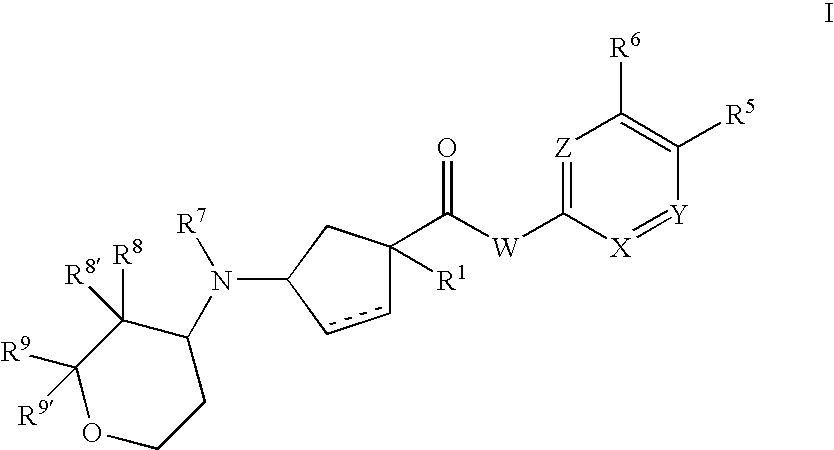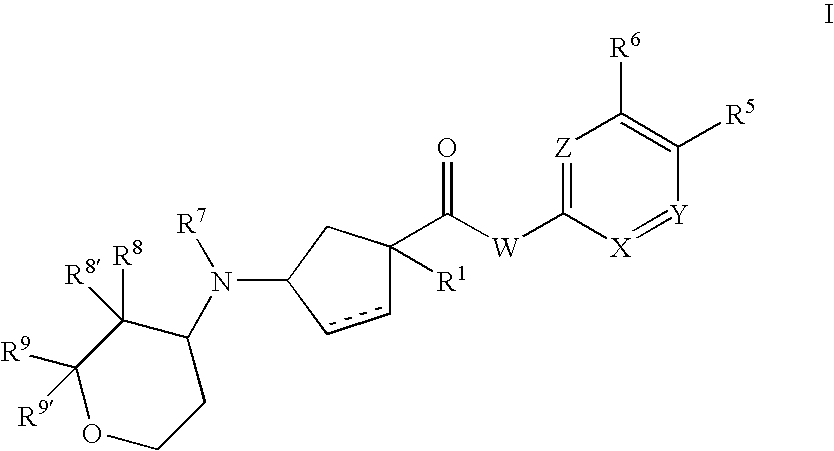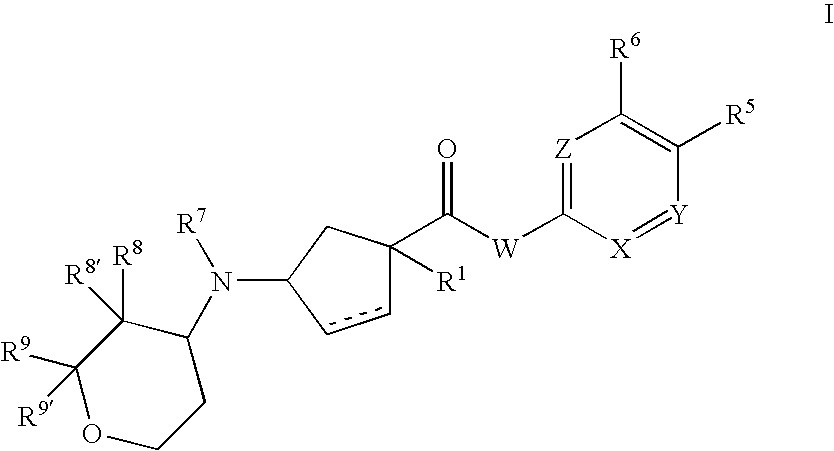3-aminocyclopentanecarboxamides as modulators of chemokine receptors
a technology of chemokine receptors and cyclopentanecarboxamides, which is applied in the direction of drug compositions, immunological disorders, metabolism disorders, etc., can solve the problem that hiv-1 has not been able to acquire resistance to any agen
- Summary
- Abstract
- Description
- Claims
- Application Information
AI Technical Summary
Benefits of technology
Problems solved by technology
Method used
Image
Examples
example 1
Preparation of N-[(1R,3S)-3-isopropyl-3-({4-[3-(trifluoromethyl)phenyl]piperazin-1-yl}carbonyl)cyclopentyl]-3-methoxytetrahydro-2H-pyran-4-amine
[0210]
Step A-1
[0211]
4,4-Dimethoxytetrahydro-2H-pyran-3-ol
[0212]To a solution of 4-methoxy-3,6-dihydro-2H-pyran (5.00 g, 43.8 mmol) in methanol (100 mL) at 0° C. was dropwise added a solution of m-chloroperbenzoic acid (15.1 g, 87.6 mmol) in methanol (15 mL). After being stirred for 5 h, methanol was removed in vacuo and the white residue was dissolved in methylene chloride (300 mL). To the solution was added K2CO3. The resulting solution was stirred for 1 h and filtered through celite. The filtrate was evaporated in vacuo to provide the desired product which was used directly for the next reaction without purification.
Step A-2
[0213]
3,4,4-Trimethoxytetrahydro-2H-pyran
[0214]To a solution of 4,4-dimethoxytetrahydro-2H-pyran-3-ol (6.00 g, 37.0 mmol) in THF (100 mL) at 0° C. was added sodium hydride (1.48 g, 37.0 mmol). After being stirred at 0° ...
example 2
[0231]
Preparation of 3-ethoxy-N-[(1R,3S)-3-isopropyl-3-({4-[3-(trifluoromethyl)phenyl]piperazin-1-yl}carbonyl)cyclopentyl]tetrahydro-2H-pyran-4-amine
Step A-1
[0232]
3-Ethoxy-4,4-dimethoxytetrahydro-2H-pyran
[0233]To a solution of 4,4-dimethoxytetrahydro-2H-pyran-3-ol (2.0 g, 12 mmol) in THF (20 mL) cooled in an ice bath was slowly added sodium hydride (0.60 g, 15 mmol) and the resulting slurry was stirred for 1 h. Iodoethane (1.5 mL, 19 mmol) was added and the mixture was stirred at room temperature overnight. More sodium hydride (0.6 g) and iodoethane (3 mL) were added and stirring was continued another overnight. The reaction was quenched with water. The resulting solution was extracted with EtOAc twice and ether twice. The combined extracts were dried, concentrated and purified on silica gel (20% EtOAc / hexanes) to give 2.1 g (90%) of desired product. 1H NMR (CDCl3) δ 3.32-4.00 (7H, m), 3.30 (3H, s), 3.20 (3H, s), 2.05-1.70 (2H, m), 1.25-1.22 (3H, m).
Step A-2
[0234]
3-Ethoxytetrahydro-...
example 3
[0238]
Preparation of N-[(1R,3S)-3-isopropyl-3-({4-[4-(trifluoromethyl)pyridin-2-yl]piperazin-1-yl}carbonyl)cyclopentyl]-3-methoxytetrahydro-2H-pyran-4-amine
Step A
[0239]
1-[4-(Trifluoromethyl)pyridin-2-yl]piperazine
[0240]A solution of 2-chloro-4-(trifluoromethyl)pyridine (2.0 g, 11 mmol), piperazine (3 g, mmol) and triethylamine (3.1 mL, 22 mmol) in DMF (10 mL) was heated at 100° C. overnight and concentrated in vacuo. The residue was purified by column chromatography on silica gel (EtOAc to EtOAc / MeOH / Et3N=9 / 1 / 0.5) to give 1.09 g (43%) of pure product MS calculated for C10H12F3N3: (M+H) 232; found 232.1.
Step B
[0241]
tert-Butyl[(1R,3S)-3-isopropyl-3-(}4-[4-(trifluoromethyl)pyridin-2-yl]piperazin-1-yl}carbonyl)cyclopentyl]carbamate
[0242]To a solution of 1-[4-(trifluoromethyl)pyridin-2-yl]piperazine (145 mg, 0.627 mmol), (1S,3R)-3-[(tert-butoxycarbonyl)amino]-1-isopropylcyclopentanecarboxylic acid (140 mg, 0.52 mmol) in methylene chloride (10 mL) was added benzotriazol-1-yloxytris(dimeth...
PUM
| Property | Measurement | Unit |
|---|---|---|
| molecular weight | aaaaa | aaaaa |
| temperature | aaaaa | aaaaa |
| temperature | aaaaa | aaaaa |
Abstract
Description
Claims
Application Information
 Login to View More
Login to View More - R&D
- Intellectual Property
- Life Sciences
- Materials
- Tech Scout
- Unparalleled Data Quality
- Higher Quality Content
- 60% Fewer Hallucinations
Browse by: Latest US Patents, China's latest patents, Technical Efficacy Thesaurus, Application Domain, Technology Topic, Popular Technical Reports.
© 2025 PatSnap. All rights reserved.Legal|Privacy policy|Modern Slavery Act Transparency Statement|Sitemap|About US| Contact US: help@patsnap.com



